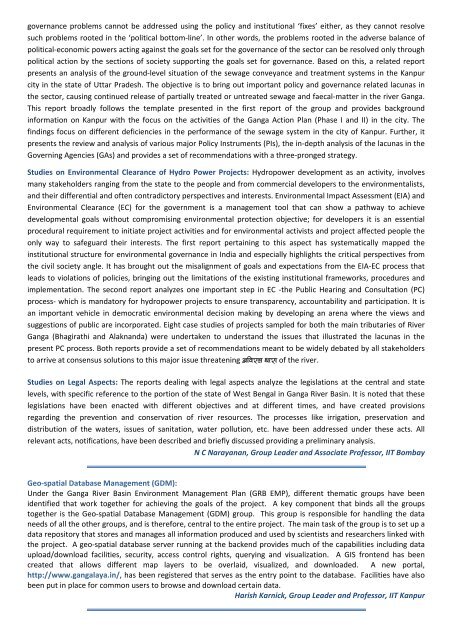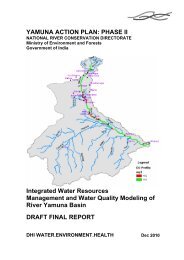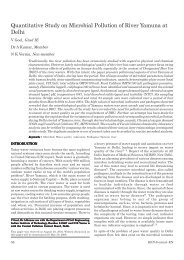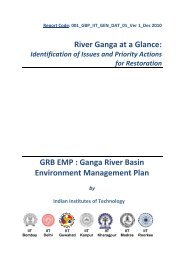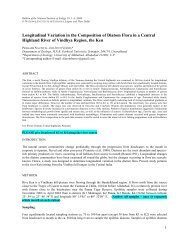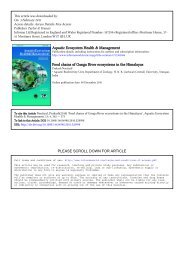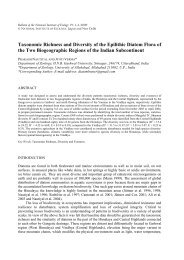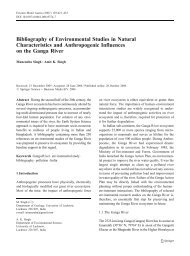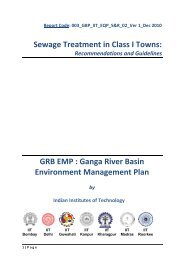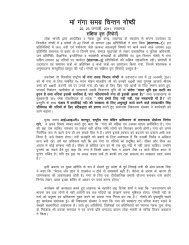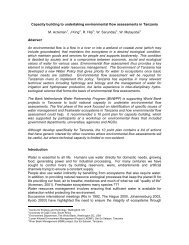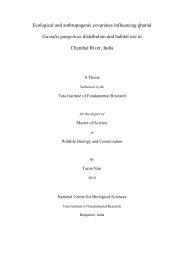GRBMP 2nd Newsletter_Final.pdf - GANGAPEDIA
GRBMP 2nd Newsletter_Final.pdf - GANGAPEDIA
GRBMP 2nd Newsletter_Final.pdf - GANGAPEDIA
You also want an ePaper? Increase the reach of your titles
YUMPU automatically turns print PDFs into web optimized ePapers that Google loves.
governance problems cannot be addressed using the policy and institutional ‘fixes’ either, as they cannot resolve<br />
such problems rooted in the ‘political bottom‐line’. In other words, the problems rooted in the adverse balance of<br />
political‐economic powers acting against the goals set for the governance of the sector can be resolved only through<br />
political action by the sections of society supporting the goals set for governance. Based on this, a related report<br />
presents an analysis of the ground‐level situation of the sewage conveyance and treatment systems in the Kanpur<br />
city in the state of Uttar Pradesh. The objective is to bring out important policy and governance related lacunas in<br />
the sector, causing continued release of partially treated or untreated sewage and faecal‐matter in the river Ganga.<br />
This report broadly follows the template presented in the first report of the group and provides background<br />
information on Kanpur with the focus on the activities of the Ganga Action Plan (Phase I and II) in the city. The<br />
findings focus on different deficiencies in the performance of the sewage system in the city of Kanpur. Further, it<br />
presents the review and analysis of various major Policy Instruments (PIs), the in‐depth analysis of the lacunas in the<br />
Governing Agencies (GAs) and provides a set of recommendations with a three‐pronged strategy.<br />
Studies on Environmental Clearance of Hydro Power Projects: Hydropower development as an activity, involves<br />
many stakeholders ranging from the state to the people and from commercial developers to the environmentalists,<br />
and their differential and often contradictory perspectives and interests. Environmental Impact Assessment (EIA) and<br />
Environmental Clearance (EC) for the government is a management tool that can show a pathway to achieve<br />
developmental goals without compromising environmental protection objective; for developers it is an essential<br />
procedural requirement to initiate project activities and for environmental activists and project affected people the<br />
only way to safeguard their interests. The first report pertaining to this aspect has systematically mapped the<br />
institutional structure for environmental governance in India and especially highlights the critical perspectives from<br />
the civil society angle. It has brought out the misalignment of goals and expectations from the EIA‐EC process that<br />
leads to violations of policies, bringing out the limitations of the existing institutional frameworks, procedures and<br />
implementation. The second report analyzes one important step in EC ‐the Public Hearing and Consultation (PC)<br />
process‐ which is mandatory for hydropower projects to ensure transparency, accountability and participation. It is<br />
an important vehicle in democratic environmental decision making by developing an arena where the views and<br />
suggestions of public are incorporated. Eight case studies of projects sampled for both the main tributaries of River<br />
Ganga (Bhagirathi and Alaknanda) were undertaken to understand the issues that illustrated the lacunas in the<br />
present PC process. Both reports provide a set of recommendations meant to be widely debated by all stakeholders<br />
to arrive at consensus solutions to this major issue threatening Aivarla Qaara of the river.<br />
Studies on Legal Aspects: The reports dealing with legal aspects analyze the legislations at the central and state<br />
levels, with specific reference to the portion of the state of West Bengal in Ganga River Basin. It is noted that these<br />
legislations have been enacted with different objectives and at different times, and have created provisions<br />
regarding the prevention and conservation of river resources. The processes like irrigation, preservation and<br />
distribution of the waters, issues of sanitation, water pollution, etc. have been addressed under these acts. All<br />
relevant acts, notifications, have been described and briefly discussed providing a preliminary analysis.<br />
N C Narayanan, Group Leader and Associate Professor, IIT Bombay<br />
Geo‐spatial Database Management (GDM):<br />
Under the Ganga River Basin Environment Management Plan (GRB EMP), different thematic groups have been<br />
identified that work together for achieving the goals of the project. A key component that binds all the groups<br />
together is the Geo‐spatial Database Management (GDM) group. This group is responsible for handling the data<br />
needs of all the other groups, and is therefore, central to the entire project. The main task of the group is to set up a<br />
data repository that stores and manages all information produced and used by scientists and researchers linked with<br />
the project. A geo‐spatial database server running at the backend provides much of the capabilities including data<br />
upload/download facilities, security, access control rights, querying and visualization. A GIS frontend has been<br />
created that allows different map layers to be overlaid, visualized, and downloaded. A new portal,<br />
http://www.gangalaya.in/, has been registered that serves as the entry point to the database. Facilities have also<br />
been put in place for common users to browse and download certain data.<br />
Harish Karnick, Group Leader and Professor, IIT Kanpur


